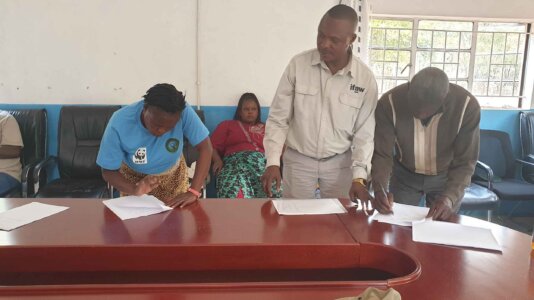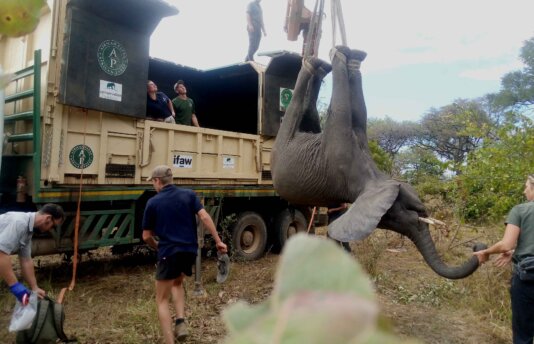- About
- Topics
- Story
- In-Depth
- Picks
- Opinion
- News
- Donate
- Signup for our newsletterOur Editors' Best Picks.Send
Read, Debate: Engage.
| December 21, 2023 | |
|---|---|
| topic: | Conservation |
| tags: | #Malawi, #Zambia, #Human-wildlife conflict, #elephants, #food security, #poaching |
| located: | Malawi, Zambia |
| by: | Charles Mpaka |
In August of this year, community leaders in Zambia’s Eastern Province gathered at a game rangers’ base just outside the main gate into Lukusuzi National Park in the Luangwa Valley.
The gathering marked the signing ceremony of an agreement between the community and the International Fund for Animal Welfare (IFAW), which is leading an ambitious conservation strategy in the Malawi-Zambia landscape.
As climate change exacerbates resource scarcity in the transboundary ecosystem, affecting access to essentials like food and water and increasing tensions between elephants and humans, IFAW is developing a strategy for humans and animals to co-exist.
The organisation’s Room to Roam initiative is based on more than 20 years of research on the dynamics of elephant populations across Southern and East Africa, according to Jason Bell, IFAW’s Executive Vice President - Strategy, Programmes and Field Operations.
"This research has shown quite clearly that, for elephants and other wildlife populations, as well as people, to thrive in the future in the face of such threats as climate change, we must maintain a network of connected ecosystems across East-Southern Africa," he told FairPlanet.
When habitats are fragmented, elephants are restricted in their movement, he highlighted. Through the Room to Roam initiative, IFAW aims "to maintain and restore a connected matrix of suitable wildlife landscapes in sub-Saharan Africa" for the safe movement of animals, according to Bell.
The 5,000-square-kilometre Malawi-Zambia landscape contains three contiguous protected areas: Kasungu National Park in Malawi and Lukusuzi and Luambe national parks in Zambia’s Luangwa valley.
Spanning between these areas is an ecological corridor comprising natural forest stands, villages and small-scale farmlands. The initiative aims to guarantee the secure passage of elephants through this corridor.
For decades, rampant poaching for ivory targeted at Asian markets has plagued the landscape, leading to a severe decline in elephant populations. In Kasungu National Park, for instance, the number of elephants plummeted from over 1,500 in the 1970s to a mere 50 in 2015, as reported by Malawi Government figures.
In 2017, IFAW launched the USAID-supported Combating Wildlife Project whose objective was to see elephant populations stabilise and grow in the landscape through a drop in poaching-related mortalities.
The project promoted joint law enforcement operations to crack down on ivory trafficking routes. It trained law enforcement agencies and the judiciary on how to investigate and prosecute wildlife crimes, and supported game rangers with essential equipment, training and housing.
The highlight of the project was the relocation in July 2022 of 263 elephants and over 300 other animals from a different Malawian national park to Kasungu National Park. This move enabled the animals to navigate into the Luangwa Valley ecosystem.
Home to over 10,000 elephants, the Luangwa valley is among the most significant wildlife refuges in Southern Africa, according to Bell. An aerial survey conducted by the Zambian government in 2015 estimated the elephant population in the Valley to be 13,800.
"However, mounting human pressure is threatening habitat viability in this ecosystem, and the threat of fragmentation is becoming more and more real," Bell said.
Under the Room to Roam initiative, IFAW is collaborating with individuals in key buffer areas in the landscape to advocate for a conservancy approach. Their strategy involves negotiating with communities to safeguard forested areas within designated corridors, facilitating the secure movement of animals between national parks.
Bell emphasised that communities play a pivotal role in the success of the initiative, adding that IFAW is actively addressing human-wildlife conflict and offers alternative livelihood and food security solutions to local residents who coexist with wildlife.
Bell admits, however, that Room and Roam is a challenging strategy to implement.
"The most significant challenge […] is finding solutions that benefit both wildlife and people," he said.
A common belief among communities is that animals in protected areas and people cannot mix. To succeed, IFAW engages in discussions with the communities, traditional leaders, governments, the private sector and local NGOs to explore practices that allow people and wildlife to live alongside each other and thrive.
As the human population in Africa swells, Bell pointed out, the competition for resources continues to intensify.
"We must act now," he said, emphasising the urgency of securing viable and connected ecosystems for elephants and other wildlife, especially in the face of the changing climate, which is expected to drive an eastwards distributional shift of both wildlife and people in Africa.
Dr Chery Mvula MBE, a community development specialist and senior consultant at Tribal Voice, a UK-based wildlife conservation organisation, emphasised that the success of this approach hinges on the depth and centrality of community involvement in both reality and practice.
Speaking to FairPlanet, she said that elephants will traverse a corridor featuring communal land and areas where people reside and cultivate crops. She expressed concerns that conflicts could intensify over time due to climate pressures affecting available water sources and people's food security.
"Poor rainfall performance, floods and high food commodity prices will inevitably fuel higher food insecurity levels and water stress in these rural communities to such an extent that the costs of living with elephants may prove too costly and lead to higher levels of human-elephant conflict," Dr Mvula said.
A recent report by the Zambia Statistics Agency indicates a general deterioration of poverty in Zambia. In the Eastern Province, where the Malawi-Zambia landscape is located, poverty rates have increased from 70 per cent in 2015 to 76 per cent in 2022, with extreme poverty rising from 56 per cent in 2015 to 62 per cent in 2022.
During the same period, the cost of living has risen by 121 per cent, the report shows.
To counter this, Dr Mvula said, the Room to Roam strategy needs to deeply and meaningfully engage communities, extending beyond "consultation on already agreed plans or tokenistic alternative livelihood projects that benefit only a few in the community."
She added, "The community’s involvement must be sought in the spirit that communities have something valuable to bring to the conservation table, not as ones who need to receive crumbs from the table."
Dr Mvula further advocates for the engagement of women in the strategy, arguing that addressing gender issues will significantly contribute to the success of the approach.
Women, she said, hold valuable indigenous knowledge about the land and natural environment in which they live and work, including migratory routes, roaming corridors of elephants and buffaloes and changing water levels at water sources. Their engagement in subsistence farming activities in the broader area, she said, further enhances their understanding.
Over the years, IFAW has collaborated with communities through established groups like Community Resources Boards (CRBs) in Zambia. These legal authorities, mandated by a 2015 Act of Parliament, engage in conservation work across game management areas and customary land.
At the August signing event, the CRBs cited lack of resources as a major challenge in their work.
Among the various terms of the agreement, IFAW will be providing the groups with grant funding for their operations to, for instance, hire community scouts, conduct mass awareness and implement conservation and livelihood activities in their villages.
Clara Mwale, leader of the one the groups, described the formalisation of the partnership as motivating.
"We are fired up now because with this agreement, we are assured of reliable support in the next five years. It also gives us a partner, in IFAW, to engage on some of our needs," Mwale told FairPlanet. "As experts, they can guide us on what other doors we can knock on for help with our conservation work."
Image by Charles Mpaka.
By copying the embed code below, you agree to adhere to our republishing guidelines.


